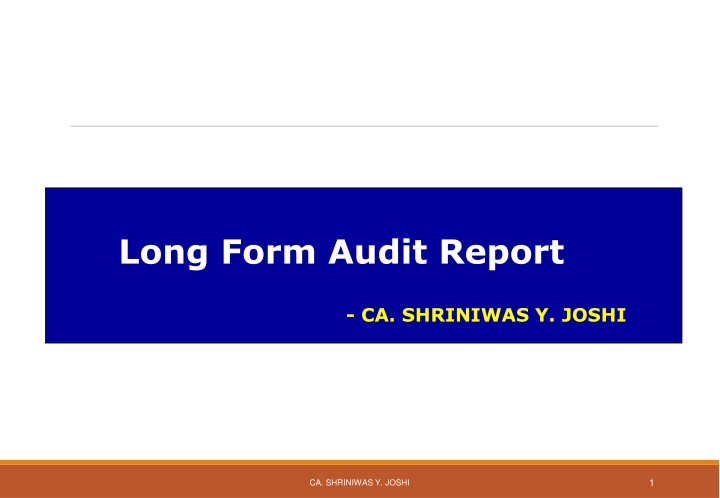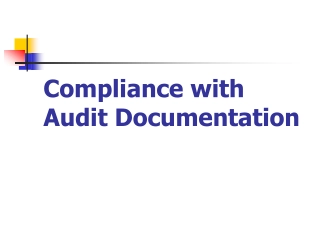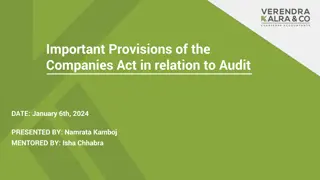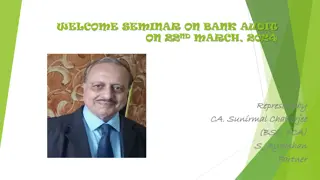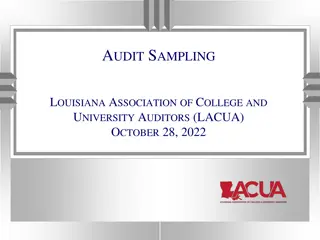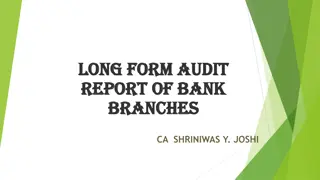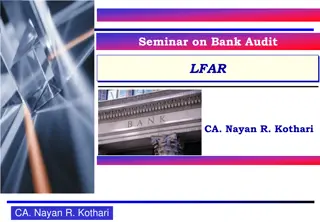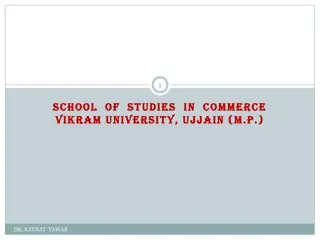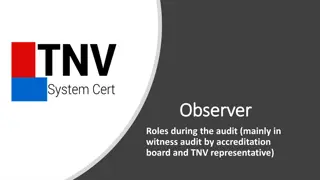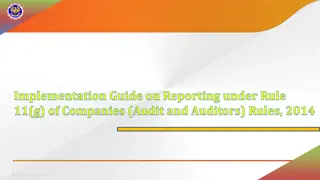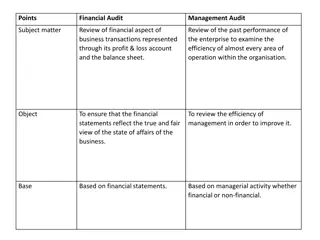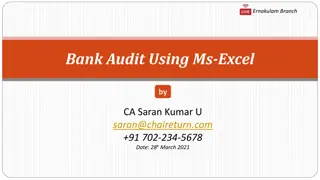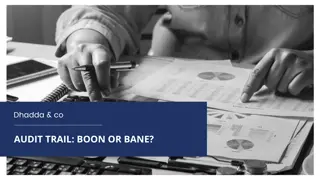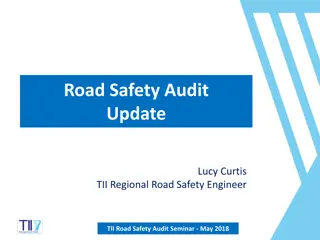Effective Tool for Auditors: Long Form Audit Report LFAR
Long Form Audit Report (LFAR) is a crucial tool for auditors to identify shortcomings in compliance and internal controls within Banks. Introduced in 1985 with subsequent revisions, LFAR helps in compiling information, making specific disclosures, and outlining weaknesses for better audit quality. It emphasizes the importance of precise answers, specific instances, and separate reports for LFAR and main audit reports. Auditors must follow guidelines diligently while preparing LFAR to draw management's attention to critical matters.
Download Presentation

Please find below an Image/Link to download the presentation.
The content on the website is provided AS IS for your information and personal use only. It may not be sold, licensed, or shared on other websites without obtaining consent from the author.If you encounter any issues during the download, it is possible that the publisher has removed the file from their server.
You are allowed to download the files provided on this website for personal or commercial use, subject to the condition that they are used lawfully. All files are the property of their respective owners.
The content on the website is provided AS IS for your information and personal use only. It may not be sold, licensed, or shared on other websites without obtaining consent from the author.
E N D
Presentation Transcript
Long Form Audit Report - CA. SHRINIWAS Y. JOSHI 1 CA. SHRINIWAS Y. JOSHI
Reporting Long Form Audit Report LFAR is a effective tool to the auditors to keep the Bank informed about lacunae, short coming and failure in respect of compliance or adherence to the Internal Controls operational in the Branch. LFAR for Branches is a separate report in a question answer format LFAR for HO is a narrative format Annexure to be given along with the LFAR which is applicable for branches having large/ irregular/ critical advance accounts having large limits LFAR introduced in 1985, subsequent revision in 1992-1993 and 2003. And now in September 2020 2 CA. SHRINIWAS Y. JOSHI
Reporting Long Form Audit Report (LFAR) The Branch is responsible for compiling the information / statements required for LFAR and the auditors should verify the same. Auditors should ensure that the documentation of files is adequate and the records and working papers are planned and filed systematically in respect of matters included in the LFAR. Regional Office / Zonal Office / Head Office / Statutory Central Auditors / External Auditors / RBI auditors etc. are the various users of the LFAR 3 CA. SHRINIWAS Y. JOSHI
Must Dos Must Do s Study the Questionnaire thoroughly. Each answer should be precise. Avoid vague or general comment. Give specific instances of weakness/shortcomings. Qualification remarks MUST be part of the main report. Make specific disclosures in respect of extent of checking, manner of sample selection, limitations on documents verified, representation received etc. 4 CA. SHRINIWAS Y. JOSHI
Must Dos Must Do s Important work to be done by partners only Training to staff is a must Main Audit Report and LFAR are two separate reports. Main Report is a self contained document and should not contain any references to LFAR. Should be sufficiently detailed and quantified to enable expeditious consolidation. Do not make current year s LFAR a replica of previous year. 5 CA. SHRINIWAS Y. JOSHI
Must Dos Must Do s LFAR Questionnaire is only indicative in nature. Auditor may report any other important matter, he wishes to draw management s attention. Give disclaimer w.r.t. any significant problem faced such as lack of availability of necessary information, lack of availability of computer system, non-availability of instructions of controlling authority, reliance placed by auditor on the computer system or reliance placed on previous year s LFAR/Concurrent and other Audit Reports 6 CA. SHRINIWAS Y. JOSHI
Must Dos Must Do s Some important areas to be noted while preparing LFAR are Information to be collected and stated Limits fixed and various instructions given by Controlling Authority Certain questions need auditor s opinion or listing cases examine and text check done Certain cases study of system presently in operation is required Certain questions required auditor to give suggestion for improvement or minimizing losses. 7 CA. SHRINIWAS Y. JOSHI
Must Dos Must Do s LFAR is of utmost importance to the management as well as the Central Auditors. Finalize Statutory Report and LFAR simultaneously. Should be well drafted. Scope of work carried out should be clearly specified. Should create an impact on the bank management about the quality of work carried out. 8 CA. SHRINIWAS Y. JOSHI
LFAR and Statutory Audit Report LFAR and Statutory Audit Report LFAR is not a substitute for the Statutory Audit Report and are two independent and different Audit Reports, hence cross-referencing for any comments or qualifications should not be done. Based on audit, if any matter having impact on true and fair view of financial statements or warrants adding qualification/Matter of emphasis in Auditor s Report (for e.g. non classification of account as NPA/ under-provision for advances)than mere reference of same in LFAR is not sufficient. 9 CA. SHRINIWAS Y. JOSHI
LFAR Mainly in 3 parts 1. Compliance 2. Deficiencies 3. Test check & Verification 10 CA. SHRINIWAS Y. JOSHI
I Assets 1. cash a. Does the system ensure that cash maintained is in effective joint custody of two or more officials, as per the instructions of the controlling authorities of the bank? b. Have the cash balances at the branch/ATMs been checked at periodic intervals as per the procedure prescribed by the controlling authorities of the bank? 11 CA. SHRINIWAS Y. JOSHI
I Assets 1. cash c. (i) Does the branch generally maintain / carry cash balances, which vary significantly from the limits fixed by the controlling authorities of the bank? (ii) Does the figure of the balance in the branch books in respect of cash with its ATM(s) tally with the amounts of balances with the respective ATMs, based on the year end scrolls generated by the ATMs? If there is any difference, same should be reported 12 CA. SHRINIWAS Y. JOSHI
I Assets 1. cash d. Whether the insurance cover available with the branch adequately meets the requirement to cover the cash-in hand and cash-in transit? 13 CA. SHRINIWAS Y. JOSHI
I Assets 2. Balances with RBI, State Bank of Balances with RBI, State Bank of India India and other banks and other banks a) Were balance confirmation certificates obtained in respect of outstanding balances as at the year-end and whether the aforesaid balances have been reconciled? The nature and extent of differences should be reported b) Observations on the reconciliation statements may be reported in the following manner: (i) Cash transactions remaining un-responded (give details) 14 CA. SHRINIWAS Y. JOSHI
I Assets 2. Balances with RBI, State Bank of Balances with RBI, State Bank of India India and other banks and other banks (b) (ii) Revenue items requiring adjustments / write- off (give details) (b)(iii) Other credit and debit entries originated in the statements provided by RBI/other banks, remaining un- responded for more than 15 days: 15 CA. SHRINIWAS Y. JOSHI
I Assets 2. Balances with RBI, State Bank of Balances with RBI, State Bank of India India and other banks and other banks (b) (iv) Where the branch maintains an account with RBI, the following additional matter may be reported: Entries originated prior to, but communicated/ recorded after the year end in relation to currency chest operations at the branch/other link branches, involving deposits into / withdrawals from the currency chest attached to such branches (Give details) (c) In case, any matter deserves special attention of the management, the same may be reported. 16 CA. SHRINIWAS Y. JOSHI
I Assets 3. Money at Call and Short Notice Money at Call and Short Notice (a) Has the branch kept money-at-call and short notice during the year? (b) Has the year-end balance been duly confirmed and reconciled? 17 CA. SHRINIWAS Y. JOSHI
I Assets 3.Money at Call and Short Notice Money at Call and Short Notice (c) Has interest accrued up to the year-end been properly recorded? (d) Whether instructions/guidelines, if any, laid down by the controlling authorities of the bank have been complied with? 18 CA. SHRINIWAS Y. JOSHI
1 Assets 4. Investments (a) In respect of purchase and sale of investments, has the branch acted within its delegated authority, having regard to the instructions/ guidelines in this behalf issued by the controlling authorities of the bank? (b) Have the investments held by the branch whether on its own account or on behalf of the Head Office/other branches been made available for physical verification? Where the investments are not in the possession of the branch, whether evidences with regard to their physical verification have been produced? 19 CA. SHRINIWAS Y. JOSHI
1 Assets 4. Investments (c) Is the mode of valuation of investments in accordance with the RBI guidelines or the norms prescribed by the relevant regulatory authority of the country in which the branch is located whichever are more stringent? (d) Whether there are any matured or overdue investments which have not been encashed and / or has not been serviced? If so, give details? 20 CA. SHRINIWAS Y. JOSHI
1 Assets 5. Advances (1) The answers to the following questions may be based on the auditor s examination of all large advances. For this purpose, large advances are those in respect of which the outstanding amount is in excess of 10% of outstanding aggregate balance of fund based and non-fund based advances of the branch or Rs.10 crores, whichever is less. Care- For all accounts above the threshold, the transaction audit/account specific details to be seen and commented, whereas below the threshold, the process needs to be checked and commented upon. Comments of the branch auditor on advances with significant adverse features, which might need the attention of the management / Statutory Central Auditors, should be appended to the LFAR. (2) The critical comments based on the review of the above and other test check should be given in respective paragraphs as given in LFAR given below. 21 CA. SHRINIWAS Y. JOSHI
1 Assets 5. Advances 1(a) List of accounts examined for audit (b) (1) Credit Appraisal In your opinion, has the branch generally complied with the procedures / instructions of the controlling authorities of the bank regarding loan applications, preparation of proposals for grant/ renewal of advances, enhancement of limits, etc., including adequate appraisal documentation in respect thereof. What, in your opinion, are the major shortcomings in credit appraisal, etc. 22 CA. SHRINIWAS Y. JOSHI
1 Assets 5. Advances (2) Have you come across cases of quick mortality in accounts, where the facility became non-performing within a period of 12 months from the date of first sanction? Details of such accounts may be provided in following manner:- Account No. Account Name Balance as at year end (3) Whether in borrowal accounts the applicable interest rate is correctly fed into the system? 23 CA. SHRINIWAS Y. JOSHI
1 Assets 5. Advances (4) Whether the interest rate is reviewed periodically as per the guidelines applicable to floating rate loans linked to MCLR / EBLR (External Benchmark Lending Rate)? (5) Have you come across cases of frequent renewal / rollover of short-term loans? If yes, give the details of such accounts. 24 CA. SHRINIWAS Y. JOSHI
1 Assets 5. Advances ( 6) Whether correct and valid credit rating, if available, of the credit facilities of bank's borrowers from RBI accredited Credit Rating Agencies has been fed into the system? (c) Sanctioning / Disbursement (1) In the cases examined by you, have you come across instances of: Credit facilities having been sanctioned beyond the delegated authority or limit fixed for the branch? Are such cases promptly reported to higher authorities? 25 CA. SHRINIWAS Y. JOSHI
1 Assets 5. Advances (2) Whether advances have been disbursed without complying with the terms and conditions of the sanction? If so, give details of such cases. (3) Did the bank provide loans to companies for buy- back of shares/securities? 26 CA. SHRINIWAS Y. JOSHI
1 Assets 5. Advances (d) Documentation (1) In the cases examined by you, have you come across instances of: Credit facilities released by the branch without execution of all the necessary documents? If so, give details of such cases. (2) Did the bank provide loans to companies for buy-back of shares/securities? 27 CA. SHRINIWAS Y. JOSHI
1 Assets 5. Advances (d) Documentation .. Contd.. (3) Advances against lien of deposits have been granted without marking a lien on the bank s deposit receipts and the related accounts in accordance with the guidelines of the controlling authorities of the bank. 28 CA. SHRINIWAS Y. JOSHI
1 Assets 5. Advances (e) Review/Monitoring/Supervision i. Is the procedure laid down by the controlling authorities of the bank, for periodic review of advances, including periodic balance confirmation / acknowledgement of debts, followed by the branch? Provide analysis of the accounts overdue for review/renewal. What, in your opinion, are major shortcomings in monitoring, etc. a. between 3 to 6 months, and (Earlier it was between 6 months to 1 year) b. over 6 months (Earlier it was over 1 year) (ii) (a) Are the stock/book debt statements and other periodic operational data and financial statements, etc., received regularly from the borrowers and duly scrutinized? Is suitable action taken on the basis of such scrutiny in appropriate cases? (b) Is the DP properlycomputed? 29 CA. SHRINIWAS Y. JOSHI
1 Assets 5. Advances (c) Whether the latest audited financial statements are obtained for accounts reviewed / renewed during the year? (iii) (a) Whether there exists a system of obtaining reports on stock audits periodically? (b) If so, whether the branch has complied with such system? (c) Details of: - cases where stock audit was required but was not conducted - where stock audit was conducted but no action was taken on adverse features 30 CA. SHRINIWAS Y. JOSHI
1 Assets 5. Advances (iv) Indicate the cases of advances to non- corporate entities with limits beyond that is set by the bank where the branch has not obtained the duly audited accounts of borrowers. (v) Does the branch have on its record, a due diligence report in the form and manner required by the Reserve Bank of India in respect of advances under consortium and multiple banking arrangements. Give the list of accounts where such certificate/report is not obtained or not available on record. (In case, the branch is not the lead bank, copy of certificate /report should be obtained from lead bank for review and record) 31 CA. SHRINIWAS Y. JOSHI
1 Assets 5. Advances (vi) Has the inspection or physical verification of securities charged to the bank been carried out by the branch as per the procedure laid down by the controlling authorities of the bank? Whether there is a substantial deterioration in value of security during financial year as per latest valuation report in comparison with earlier valuation report on record? (vii)In respect of advances examined by you, have you come across cases of deficiencies, including in value of securities and inspection thereof or any other adverse features such as frequent/ unauthorized overdrawing beyond limits, inadequate insurance coverage, etc.? 32 CA. SHRINIWAS Y. JOSHI
1 Assets 5. Advances (viii) Whether the branch has any red-flagged account? If yes, whether any deviations were observed related to compliance of bank's policy related with Red Flag Accounts? (ix) Comment on adverse features considered significant in top 5 standard large advances and which need management's attention. 33 CA. SHRINIWAS Y. JOSHI
1 Assets 5. Advances (x) In respect of leasing finance activities, has the branch complied with the guidelines issued by the controlling authorities of the bank relating to security creation, asset inspection, insurance, etc.? Has the branch complied with the accounting norms prescribed by the controlling authorities of the bank relating to such leasing activities? 34 CA. SHRINIWAS Y. JOSHI
1 Assets 5. Advances (f) (i) Asset Classification, Provisioning of Advances and Resolution of Stressed Assets a) Has the branch identified and classified advances into standard / substandard / doubtful / loss assets through the computer system, without manual intervention? b) Is this identification & classification in line with the norms prescribed by the Reserve Bank of India 35 CA. SHRINIWAS Y. JOSHI
I Assets 5. Advances General Instructions General Instructions (c) Whether the branch is following the system of classifying the account into SMA-0, SMA-1, and SMA-2. Whether the auditor disagrees with the branch classification of advances into standard (Including SMA-0, SMA-1, SMA-2) / sub-standard / doubtful / loss assets, the details of such advances with reasons should be given (d) Also indicate whether required changes have been incorporated/ suggested in the Memorandum of Changes. 36 CA. SHRINIWAS Y. JOSHI
I Assets 5. Advances General Instructions General Instructions e) List the accounts (with outstanding in excess of Rs. 10.00 crore) which have either been downgraded or upgraded with regard to their classification as Non-Performing Asset or Standard Asset during the year and the reason thereof. f) Whether RBI guidelines on income recognition and provisioning have been 37 CA. SHRINIWAS Y. JOSHI
I Assets 5. Advances General Instructions General Instructions (ii)a) Whether the branch has reported accounts restructured or rephased during the year to Controlling Authority of the bank? b) Whether the RBI Guidelines for restructuring on all such cases have been followed. c) Whether the branch complies with the regulatory stance for resolution of stressed assets, including the compliance with board approved policies in this regard, tracking/reporting of defaults for resolution purposes among others? 38 CA. SHRINIWAS Y. JOSHI
I Assets 5. Advances General Instructions General Instructions (iii) a) Whether the upgradations in non-performing advances is in line with the norms of Reserve Bank of India b) Where the auditor disagrees with upgradation of accounts? If yes, give reasons thereof. (iv) Have you come across cases where the relevant Controlling Authority of the bank has authorized legal action for recovery of advances or recalling of advances, but no such action was taken by the branch? If so, give details of such cases. (v) Whether there are any accounts wherein process under IBC is mandated but not initiated by the branch? Whether there are any borrowers at the branch against whom the process of IBC is initiated by any of the creditors including bank? If yes, provide the list of such accounts and comment on the adequacy of provision made thereto? 39 CA. SHRINIWAS Y. JOSHI
I Assets 5. Advances General Instructions General Instructions (vi)a) Have appropriate claims for credit guarantee (ECGC and others), if any, been duly lodged and settled? b) Give details of claims rejected? (As per the given table) c) Whether the rejection is appropriately considered while determining the provisioning 40 CA. SHRINIWAS Y. JOSHI
I Assets 5. Advances General Instructions General Instructions (vii) In respect of non-performing assets, has the branch obtained valuation reports from approved valuers for the immovables charged to the bank, once in three years, unless the circumstances warrant a shorter duration? (viii) In the cases examined by you, has the branch complied with the Recovery Policy prescribed by the controlling authorities of the bank with respect to compromise/settlement and write- off cases? Details of the cases of compromise/settlement and write-off cases involving write-offs/waivers in excess of Rs. 50.00 lakhs may be given. (ix) Is the branch prompt in ensuring execution of decrees obtained for recovery from the defaulting borrowers? Give Age-wise analysis of decrees obtained and pending execution. 41 CA. SHRINIWAS Y. JOSHI
I Assets 5. Advances General Instructions General Instructions (x) Whether in the cases concluded the recoveries have been properly appropriated against the principal / interest as per the policy of the bank? (xi) In cases where documents are held at centralized processing centres / office, whether the auditor has received the relevant documents as asked by them on test check basis and satisfied themselves. Report the exceptions, if any (xii) List the major deficiencies in credit review, monitoring and supervision 42 CA. SHRINIWAS Y. JOSHI
I Assets 5. Advances General Instructions General Instructions g) Non-Fund Based facilities i. List of borrowers with details of LCs devolved or guarantees invoked during the year. (Earlier it was "at the end of the year") 43 CA. SHRINIWAS Y. JOSHI
I Assets 5. Advances General Instructions General Instructions ii. List of borrowers where the LCs have been devolved or guarantees have been invoked but not paid with amount thereof. 44 CA. SHRINIWAS Y. JOSHI
I Assets 5. Advances General Instructio General Instructions ns (iii) List of instances where interchangeability between fund based and non-fund-based facilities was allowed subsequent to devolvement of LC / invocation of BG. 45 CA. SHRINIWAS Y. JOSHI
I Assets 6. Other Assets Other Assets (a)(i)Suspense Accounts/Sundry Assets Does the system of the bank ensure expeditious clearance of items debited to Suspense Account? Details of outstanding entries in excess of 90 days may be obtained from the branch and the reasons for delay in adjusting the entries may be ascertained. Does your scrutiny of the accounts under various sub-heads reveal balances, which in your opinion are not recoverable and would require a provision/write-off? If so, give details. (ii) Does your test check indicate any unusual items in these accounts? If so, report their nature and the amounts involved. Are there any intangible items under this head e.g. losses not provided / pending investigation? 46 CA. SHRINIWAS Y. JOSHI
2 Liabilities 1. Deposits (a) Does the bank have a system of identification of dormant/ inoperative accounts and internal controls with regard to operations in such accounts? In the cases examined by you, have you come across instances where the guidelines laid down in this regard have not been followed? If yes, give details thereof. (b) After the balance sheet date and till the date of audit, whether there have been any unusual large movements (whether increase or decrease) in the aggregate deposits held at the year-end? If so, obtain the clarifications from the branch and give your comments thereon. 47 CA. SHRINIWAS Y. JOSHI
2 Liabilities 1. Deposits (c) Whether the scheme of automatic renewal of deposits applies to FCNR(B) deposits? Where such deposits have been renewed, report whether the branch has satisfied itself as to the 'non-resident status' of the depositor and whether the renewal is made as per the applicable regulatory guidelines and the original receipts / soft copy have been dispatched. (d) Is the branch complying with the regulations on minimum balance requirement and levy of charges on non- maintenance of minimum balance in individual savings accounts? 48 CA. SHRINIWAS Y. JOSHI
2 Liabilities 2.Other Liabilities (a) The number of items and the aggregate amount of old outstanding items pending for one years or more be obtained from the branch and reported under appropriate heads. Give details thereof. (b) Does your test check indicate any unusual items or material withdrawals or debits in these accounts? If so, give details thereof. 49 CA. SHRINIWAS Y. JOSHI
2 2 Liabilities Liabilities 3 3. . Contingent Liabilities Contingent Liabilities List of major items of the contingent liabilities (other than constituent s liabilities such as guarantees, letter of credit, acceptances, endorsements, etc.) not acknowledged by the branch? 50 CA. SHRINIWAS Y. JOSHI
